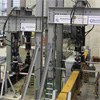Bowen Lab Projects - Steel
Member-level Redundancy in Built-up Steel Members
The objective of this research is to quantify the redundancy possessed by built-up steel members (bolted or riveted). Typically, built-up members will not 'fail' if one of the components fails (whether through fatigue or fracture). However, there is very little experimental data quantifying the remaining fatigue life and strength of a member in which one of the components has failed.
Laboratory Testing of Railroad Flatcars For Use as Highway Bridges on Low-Volume Roads to Determine Ultimate Strength and Redundancy
Several counties in Indiana use retired railroad flatcars for a bridge superstructure to replace existing deteriorating county bridges. There are over 130 railroad flatcar bridges in the state of Indiana. The main objective of this laboratory project is to provide greater confidence to county engineers when load rating these bridges by studying the ultimate strength and load redundancy of the bridge system. Testing in the laboratory creates the opportunities to test at larger loads, use a greater number of instrumentation, and simulate a controlled fracture test.
Structural Integrity of Steel Gravity Framing Systems - Purdue Slab Component Tests
Component tests on the concrete slab on metal deck include uniaxial tests to evaluate behavior in both orthogonal directions with respect to the deck corrugations, and shear and tension tests of the sidelap splices. Parameters include metal deck thickness and type of sidelap (e.g., button punch, screw, weld). This study is part of a collaborative research project with U. Washington (connection tests) and U.Illinois (system tests). Test results will be used to validate and update computational models for evaluation of robustness of steel buildings.
Response of Fire Loading on Multi-story Continuous Steel Columns
This project investigates the inelastic buckling analysis of continuous steel wide flange gravity columns under partial fire loading. During a fire event, portions of the building may remain at ambient conditions despite other areas of the structure heated by fire. The goal of this research is to study the behavior of inelastic column buckling during an isolated fire event and determine the magnitude of the stabilizing moments gained through surrounding ambient structural elements.
Fatigue Cracking and Inspection of High-mast Lighting Towers
Recent failures of high-mast lighting towers in several states have raised questions as to the robustness and safety of the existing inventory of similar structures. Failure of these structures is very critical as they are typically located adjacent to Interstates or other high-speed highways.
AASHTO Fracture Control Plan and Revisions to LRFD Fatigue Design Specifications
Primarily in response to failures during the late 1960's and 1970's, the material, design, fabrication, shop inspection, and in-service inspection requirements were improved for steel bridges in general. Special provisions for fracture critical members (FCM) were later implemented in 1978 mainly in reaction to bridge collapses.
Viewing 1 to 6 of 6






